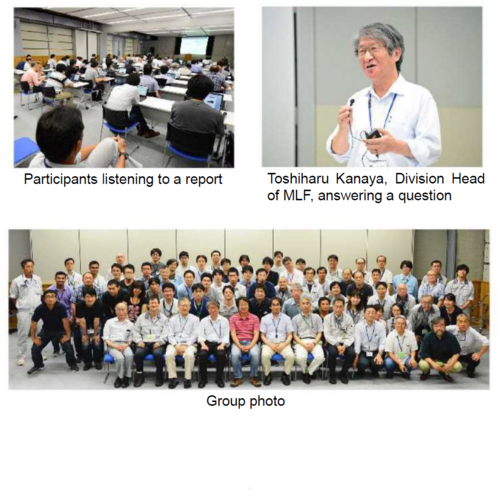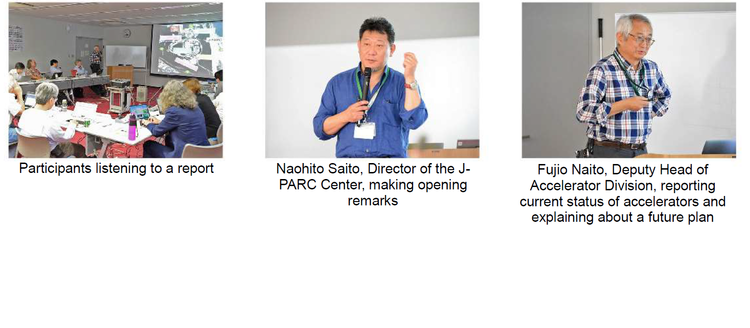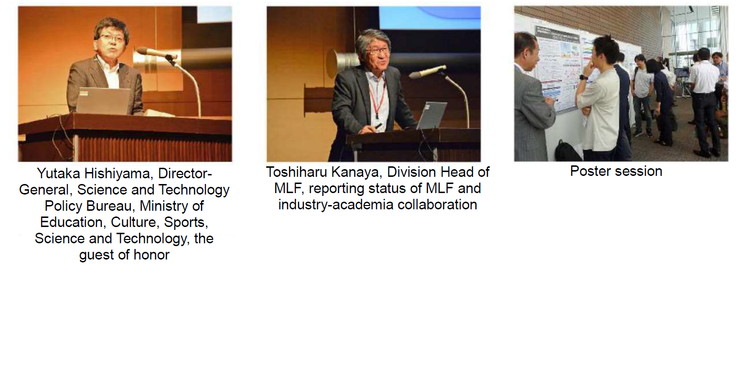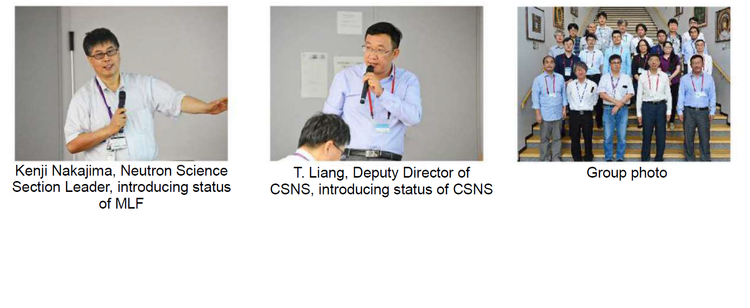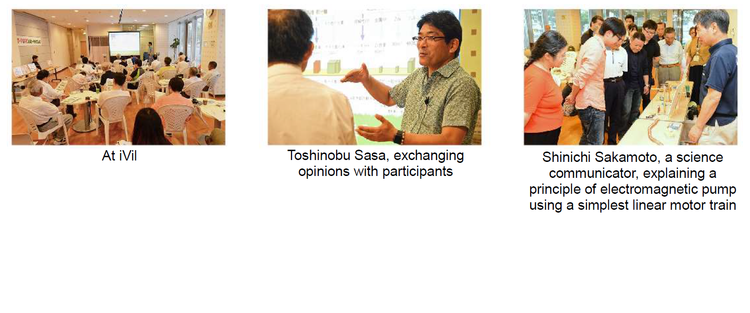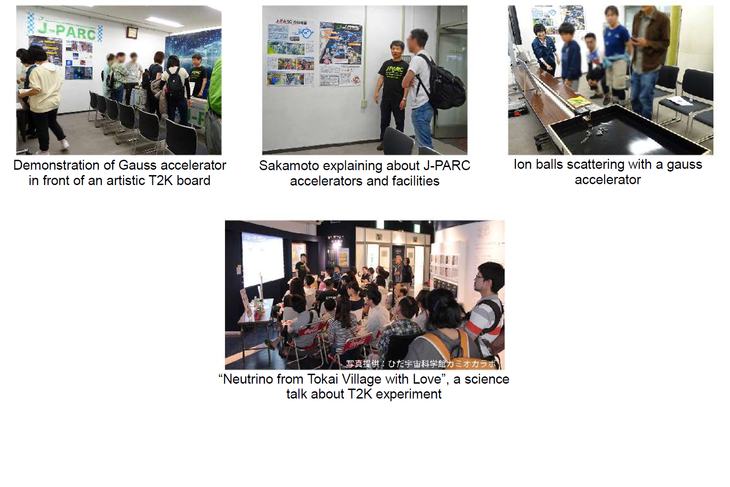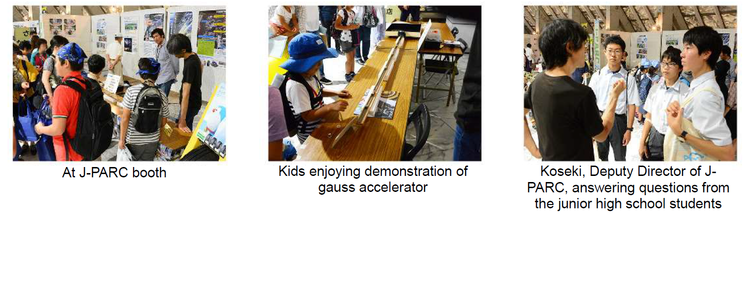J-PARC NEWS July 2019 (Issue #171)
■2nd MLF General Meeting held in 2019 (July 10, IQBRC)
The second general meeting of the MLF (Materials and Life Science Experimental Facility) for this year was held on July 10 at the Ibaraki Quantum Beam Research Center (IQBRC). Four general meetings are scheduled to be held a year beginning this year, where researchers involved in MLF participate from J-PARC, the Comprehensive Research Organization for Science and Society (CROSS), and the Ibaraki Prefecture Beamline (Ibaraki University), aiming to exchange information on their current situations and deepen mutual understanding for a problem solving approach. The division chief reported the current situation of MLF, the way of promoting industry-academia collaboration etc., and an ideal MLF operation system. Each leader presented a report entitled “Future Plans and Challenges”, and the people of CROSS and the Ibaraki Prefecture Beamline presented reports on the activities of each organization. In addition, newcomers assigned to each section and CROSS introduced themselves and their research background etc. They interacted with each other in a friendly atmosphere.
■ 28th J-PARC PAC (July 16 to 18, J-PARC)
The J-PARC Program Advisory Committee (PAC) for the Nuclear and Particle Physics Experiments was held over three days from July 16, with Prof. Kam-Biu Luk of the University of California, Berkeley, newly joining the Commissioners. At the beginning, Naohito Saito, Director of the J-PARC Center, gave the opening address and reported on the current status of J-PARC, and Fujio Naito, Deputy Director of the Accelerator Division, reported on the current status and future operation plans of the J-PARC accelerator. In addition, Katsuo Tokushuku, Director of the KEK Institute of Particle and Nuclear Studies, requested the committee to discuss the proposed experimental issues. Subsequently, each person in charge of the experiments currently being conducted at the Hadron experimental facility and the neutrino experimental facility at J-PARC gave a report, and they reviewed whether the proposed task should be adopted or not. On the final day, a tour of the Hadron experimental hall took place.
■Debriefing on the industrial use of J-PARC MLF (July 18 to 19, Akihabara Convention Hall, Tokyo)
The J-PARC Center held its fourth debriefing session on the industrial use of MLF this year on July 18th and 19th, with many participants coming from companies, universities and research institutes. On the first day of the session, a new concept of J-PARC JOIN, with the aim of vitalizing the industrial use of instruments promoted by MLF (JAEA & KEK), Ibaraki Prefecture, and the Comprehensive Research Organization for Science and Society (CROSS), was introduced. Under the new concept, they are making efforts to listen to opinions of industrial circles and share information on their cooperative relationships. Additionally, in regards to muon, which has recently received much attention from the industrial world as a new probe, Yasuhiro Miyake, Deputy Director of the Division of MLF, gave a talk on "the possibility of industrial use of muon", and some users presented actual examples of using muon for battery analysis. On the second day, current status of facility use and industrial use achievements of the four neutron beamlines were reported to show a part of activity for the "Joint Creation of Innovation" performed by the relevant facilities and industrial circles, furthermore, opinions for further promotion were received and discussed in depth. In the poster session, collaborative presentations with quantum beam related facilities such as SPring-8 were made, and questions and answers were actively exchanged.
■ J-PARC Workshop “CSNS-J-PARC Collaboration Workshop on Neutron Instrumentation” (July 22 to 24, J-PARC)
For three days beginning from July 22nd, a J-PARC workshop on neutron experiment equipment was held with Chinese spallation neutron source (CSNS). CSNS has been in operation since 2017, and currently three neutron experiment units are operated at 50 kW. This time, Deputy Directors, F. Wang and T. Liang, and eight researchers from CSNS who were involved in researches on radiation sources and equipment visited J-PARC, and exchanged information on the current status and future development plans for the experimental facility etc. with the persons in charge of MLF experiment equipment. T. Liang, Deputy Director, reported the current status of CSNS facilities, followed by presentations by persons in charge of each equipment in operation or under construction. On the first day, a tour of the MLF was also conducted, with questions and answers actively exchanged in response to the explanation of the MLF experimental equipment. On the final day, the possibility of future cooperation on R&D was discussed.
■30th J-PARC Hello Science: Liquid metal connects accelerator with reactor “– Reduce nuclear waste through an accelerator-driven system –” (June 28, Tokaimura, Industry/Information Plaza iVil)
Disposal of radioactive wastes generated from nuclear power plants would be much easier if the wastes could be separated and reduced through nuclear transmutation (conversion into short lived materials). At J-PARC, we are developing technologies of an accelerator-driven system (ADS) that transmutes radioactive materials separated from nuclear wastes. For the third time, Dr. Toshinobu Sasa, a leader of the Target Technology Development Section, explained the characteristics of a liquid metal which is used as the "coolant" and the "neutron generation target" of ADS and its application technology, after mentioning summary of his past talks. In his talk, he explained the principle of the electromagnetic pump which drives liquid metal by electromagnetic force with showing simple experiments. He also introduced the launch of an ADS development plan in Belgium. There was high public interest and many repeaters visited iVil.
■J-PARC booth exhibited in GSA (July 13 to 14, at Kamioka Public Hall, Kamioka-town, Hida City)
Geo Space Adventure (GSA) mainly provides tours to Super-Kamiokande (SK). It is operated by some volunteers from Hida City. The tour is held for two days every July at the Institute for Cosmic Ray Research. University of Tokyo, set up there by utilizing the mining site of the Ikenoyama Kamioka mine, and other places. Tour participants can learn about the history at an underground research facility which is not usually open to public, observe the demonstration of heavy equipment used for mining ores, and learn and deepen their understanding of neutrinos. This is an event that has aroused high interest from around the country. There are twice as many entries as 400 people for the event every year even though the participants limit is 400 people for each day. J-PARC plays a part in the T2K international collaboration* that pursues neutrino research by shooting neutrinos towards SK. J-PARC began to participate in this event two years ago, and also this year, four staff members of the Public Relations Section, including Dr. Shinichi Sakamoto, as a science communicator, carried out PR activities for J-PARC. There were posters, video display and exhibition model of accelerators, demonstration of a gauss accelerator that uses magnets to accelerate an iron ball and strikes it against a cluster of small iron balls and ferrite magnets, which is reminiscent of a nucleus, to help the visitors understand how secondary particles such as neutrinos are generated from a nucleus. Many people listened attentively to Dr. Sakamoto's Science Talk on T2K experiment given twice a day in a two-day event at the Hida Space Science Museum ‘Kamioka Lab’. Some of the participants even asked academic questions concerning the mechanism of neutrino oscillation etc., and all events favorably received.
* This is referred to as T2K experiment’s an abbreviation of “from Tokai to Kamioka” (Tokai to Kamioka).
■“Eco-Festival Hitachi 2019” in Hitachi City (July 20, Hitachi Civic Center)
The J-PARC Center had a booth exhibited for the “Eco-Festival Hitachi 2019” held on July 20 at the Hitachi Civic Center, New City Square, and the Marble Hall. Eco-Festival Hitachi is the largest environmental event in Ibaraki Prefecture where products and technology of companies carrying out environment-friendly activities, as well as the contents of activities of environmental groups in Hitachi City etc. are presented. At present, researches on neutron applications etc. are actively pursued in J-PARC's MLF, and companies are working to develop tires and storage batteries with eco-friendly and high-performance. At the booth, in addition to the staff of the PR Section, Director of the J-PARC Center Naohito Saito, et al. introduced the research carried out in J-PARC with posters, etc., explained the accelerator using a synchrotron accelerator model, exhibited the commercialized eco-tires, and provided experience and demonstration of a gauss accelerator, etc. Cheers broke out, not only from children but also from adults, when the iron ball reached a considerable speed in an instant.

